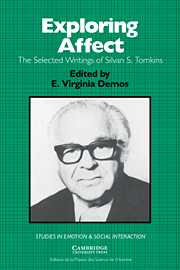Book contents
- Frontmatter
- Contents
- Foreword
- Editor's preface
- List of contributors
- Chronology
- Introduction
- Part I Affect theory
- Introduction
- Selections by Silvan S. Tomkins
- Part II Affect and ideology
- Introduction
- Selections by Silvan S. Tomkins
- Part III The face of affect
- Introduction
- Selections by Silvan S. Tomkins
- Part IV Script theory: The differential magnification of affect
- Introduction
- Selections by Silvan S. Tomkins
- The rise, fall, and resurrection of the study of personality
- Script theory
- Revisions in script theory – 1990
- The varieties of shame and its magnification
- Part V Human being theory: A foundation for the study of personality
- Introduction
- Selections by Silvan S. Tomkins
- A complete annotated bibliography of Silvan S. Tomkins's writings
- References
- Author index
- Subject index
- Titles in the series
Revisions in script theory – 1990
Published online by Cambridge University Press: 10 November 2010
- Frontmatter
- Contents
- Foreword
- Editor's preface
- List of contributors
- Chronology
- Introduction
- Part I Affect theory
- Introduction
- Selections by Silvan S. Tomkins
- Part II Affect and ideology
- Introduction
- Selections by Silvan S. Tomkins
- Part III The face of affect
- Introduction
- Selections by Silvan S. Tomkins
- Part IV Script theory: The differential magnification of affect
- Introduction
- Selections by Silvan S. Tomkins
- The rise, fall, and resurrection of the study of personality
- Script theory
- Revisions in script theory – 1990
- The varieties of shame and its magnification
- Part V Human being theory: A foundation for the study of personality
- Introduction
- Selections by Silvan S. Tomkins
- A complete annotated bibliography of Silvan S. Tomkins's writings
- References
- Author index
- Subject index
- Titles in the series
Summary
I am going to make a confession to you, that I did not altogether understand my own theory, which is not all that unusual. But it shook me up a bit, because it took me about three years to discover, like Molière's gentleman, that I have been speaking prose all this while. In constructing script theory, some of the scripts were defined by affect purposes. For example, affect control scripts have as their main aim the control of affect. Affect management scripts have as their main aim the management of affect when control is a problem, that is, when you have residual, backed-up affect that you do not know what to do with. So each script in part creates some more business. There are a few different kinds of affect management scripts, but let me just mention one kind to illustrate how I was misled.
In an affect management script of a sedative type, the rules define sedation, a sedation script, as looking at a scene and disregarding most of what is going on in the scene, while looking primarily at the negative affect which that scene arouses in you and devising a strategy for managing that negative affect. That is all. This turned out to be a major species of substance dependency. I developed these ideas in a ten-year program of research on smoking as a dependency. I found that there were vital differences between people who had addictive scripts and people who had sedative scripts.
- Type
- Chapter
- Information
- Exploring AffectThe Selected Writings of Silvan S Tomkins, pp. 389 - 396Publisher: Cambridge University PressPrint publication year: 1995



